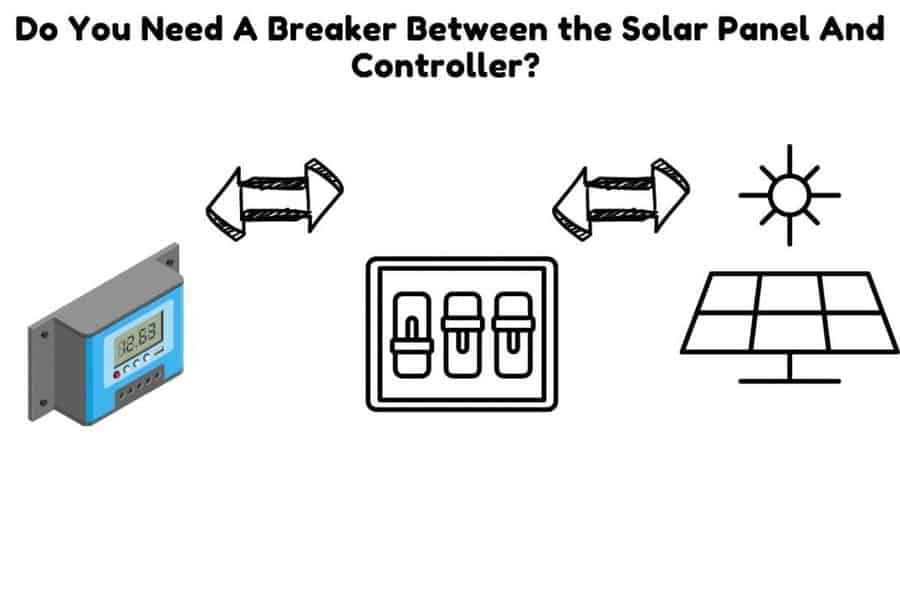Electricity travels at the speed of light or about 186,000 miles per second. Solar panels are mini power plants that produce enough electricity to power skyscrapers. But can solar panels produce too much electricity?
Fuses and breakers are overcurrent protection devices that regulate the current going from a solar panel and the other components in the system. They are there to protect the conductors from an overload of too much current.
There are different types of fuses and breakers used in a solar system. It can get a little confusing trying to figure out where you should have them or even if you need them at all. In this guide, we clear up some of that confusion by explaining what purpose an overcurrent protection device serves in a solar system and where you should use them.

Do Solar Panels Need Circuit Breakers?
Circuit breakers are one of two types of overcurrent protection devices (OCP). The second type of OCP is a fuse. Circuit breakers are not strictly mandatory. They do, however, add an extra layer of safety if something should go wrong in the system. Circuit breakers are generally recommended for solar panels that generate more than 100 watts of power.
On a side note! If you’re in need of a reliable and high-performance portable solar panel, We strongly recommend the Jackery SolarSaga 100W Portable Solar Panel (Amazon Link).
With a high conversion efficiency and foldable design, this solar panel is easy to transport and set up, making it perfect for outdoor activities like camping, hiking, and RV trips.

The US solar cell technology used in this panel ensures that you get the most efficient and reliable solar charging possible.
There is also a 60W option that is more affordable (Amazon Link)
An overcurrent protection device opens a circuit when there is too much current. Opening a circuit cuts off the flow of current. When there is an excess of current passing through the circuit breaker, the breaker will trip or break to stop the current flow.
Circuit breakers for solar panel systems are similar to the ones installed in most homes. They might look a little different but they perform the same function.
Circuit breakers are thermally activated. They can also use magnetic or electric sensors. In a thermally activated breaker, when the breaker reaches a pre-set temperature, it trips. All you need to do to get the current flowing again is to reset it.
This is the advantage circuit breakers have over fuses. Pass too much current through a fuse and it burns out then you have to replace it.
Circuit breakers are typically used on the AC side of solar systems or from the inverter. They are also used on the DC side of low-voltage, battery-based arrays. This could be from the solar panels into the batteries, inverter, or out from the inverter.
Without a circuit breaker, there is nothing to protect the components and conductors in the circuit from overheating or damage as a result of an overload. In extreme cases, this will result in an electrical fire. Source
Also, find out Can A Solar Panel Be Overloaded? What Happens!
What Size Breaker Do I Need For Solar Panels?
Circuit breakers come with a specific voltage and current rating as well as the current type (AC or DC). The size of the breaker depends on the size of the solar array and how it is designed. Sizing breakers for a parallel array is different from sizing for solar panels wired in series. A rule of thumb is to oversize the breaker by 125%.
Sizing for solar panels wired in series
For a series array, you would take the amperage of your solar panels and multiply it by 25%. Let’s say for example you had two solar panels of 100 watts. They each produce 20 volts and 5 amps. The total output would be 40 volts and 5 amps. The amperage stays the same but the voltage increases when you wire solar panels in series.
The equation for working out the size of the circuit breaker would then look like this:
5A (amps) X 1.25 = 6.25A.
In this case, you would then use the closest available size of breaker which would be a 10A.
for more on this topic, check out our post “What Size Breaker Do You Need For A 200-Watt Solar Panel? Sizing Guide!“
Sizing for solar panels wired in parallel
The calculation for solar panels wired in parallel is slightly different because the amperage adds up but the voltage remains the same in a parallel connection. Now we have 20 volts and 10 amps. Using the same two 100-watt solar panels this is what the calculation would look like.
10A x 1.25 = 12.5A
In this case, you would use a 15A size breaker.
Circuit breakers can be used for the entire system by having one breaker that shuts down the whole system. There is also the option of having multiple circuit breakers between individual solar panels. This allows you more safety in the case of an emergency.
Circuit breakers are good protection against a short circuit in the system. A short can create a build-up of high temperature which can burn the conductors and the components in a system.
Should You Put A Fuse Between Charge Controller And Battery?
Fuses and circuit breakers are used throughout a solar system. There are three main points where fuses are placed in a system. The first is between the solar panels and the charge controller. The second is between the charge controller and batteries. The third is between the batteries and the inverter.
Having fuses at each of these points isolates the components and ensures current overflow does not go further than one point of your system.
What Size Fuse Do You Need Between Solar Panel And Charge Controller?
Estimating the size of the fuse between the charge controller is relatively simple. The fuse size should be equivalent to the amperage produced by the charge controller. If a charge controller is rated at 40 amps, then the fuse should be 40A.
In most cases, the manufacturer will state both the amperage provided by the charge controller and the amperage of the fuse you should use.
Sizing the fuse between the battery and the inverter is also simple. Usually, the inverter will have a built-in fuse or breaker in which case you do not have to add a fuse. If the inverter does not have a fuse, the recommended fuse size will typically be given by the manufacturer in the manual.
You could also use the rule of thumb given for sizing the fuse between the solar array and the charge controller. In other words, the fuse would be 125% of the inverter output. If the inverter produces 83 amps this is what that would look like:
83A x 1.25 = 105A.
The next best size amp you would likely find is a 150A. Source

